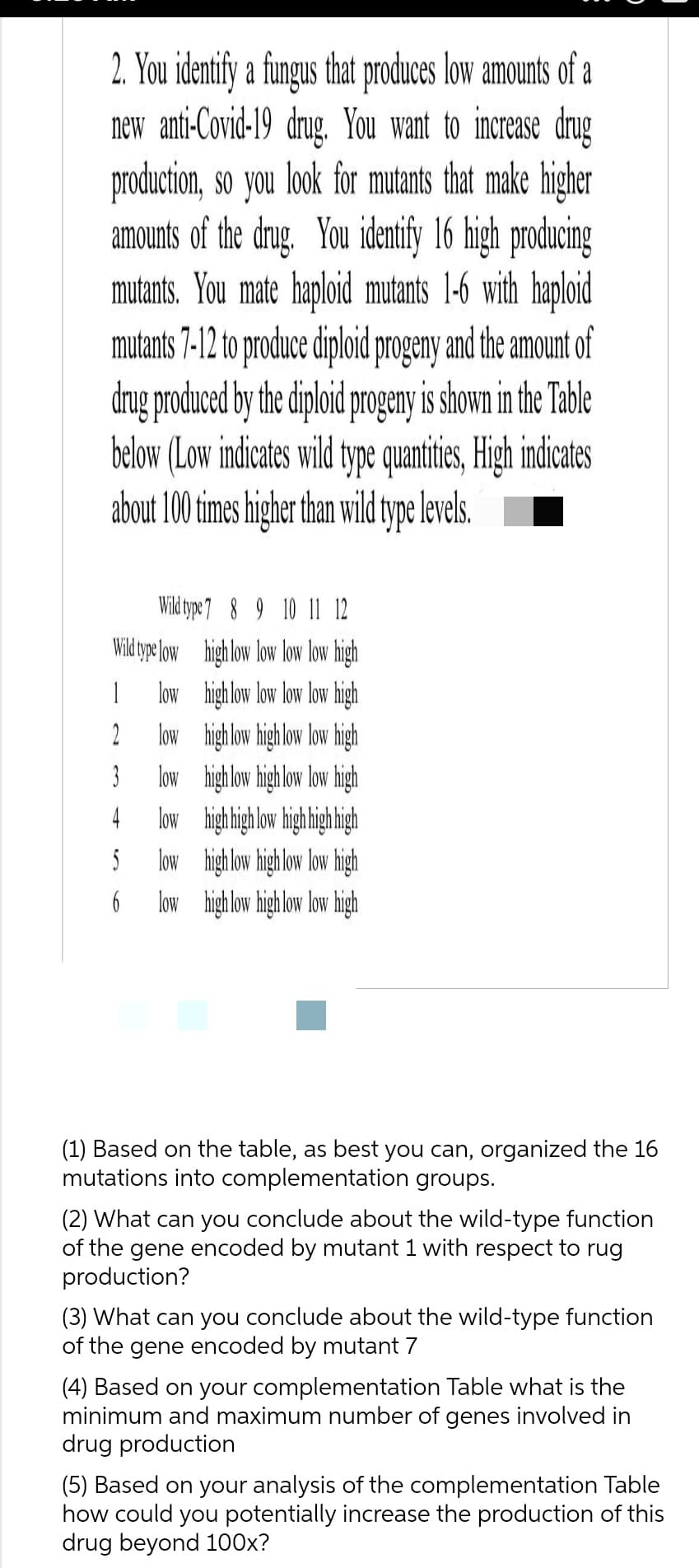production, so you look for mutants that make higher amounts of the drug. You identify 16 high producing mutants. You mate haploid mutants 1-6 with haploid mutants 7-12 to produce diploid progeny and the amount of drug produced by the diploid progeny is shown in the Table below (Low indicates wild type quantities, High indicates about 100 times higher than wild type levels. Wild type 7 8 9 10 11 12 Wild type low high low low low low high 1 low high low low low low high 2 low high low high low low high 3 low high low high low low high low high high low high high high low high low high low low high low high low high low low high 5 6
production, so you look for mutants that make higher amounts of the drug. You identify 16 high producing mutants. You mate haploid mutants 1-6 with haploid mutants 7-12 to produce diploid progeny and the amount of drug produced by the diploid progeny is shown in the Table below (Low indicates wild type quantities, High indicates about 100 times higher than wild type levels. Wild type 7 8 9 10 11 12 Wild type low high low low low low high 1 low high low low low low high 2 low high low high low low high 3 low high low high low low high low high high low high high high low high low high low low high low high low high low low high 5 6
Biology: The Dynamic Science (MindTap Course List)
4th Edition
ISBN:9781305389892
Author:Peter J. Russell, Paul E. Hertz, Beverly McMillan
Publisher:Peter J. Russell, Paul E. Hertz, Beverly McMillan
Chapter18: Dna Technologies: Making And Using Genetically Altered Organisms, And Other Applications
Section: Chapter Questions
Problem 8TYK
Related questions
Topic Video
Question
100%
Plz asap

Transcribed Image Text:2. You identify a fungus that produces low amounts of a
new anti-Covid-19 drug. You want to increase drug
production, so you look for mutants that make higher
amounts of the drug. You identify 16 high producing
mutants. You mate haploid mutants 1-6 with haploid
mutants 7-12 to produce diploid progeny and the amount of
drug produced by the diploid progeny is shown in the Table
below (Low indicates wild type quantities, High indicates
about 100 times higher than wild type levels.
Wild type 7 8 9 10 11 12
high low low low low high
high low low low low high
high low high low low high
high low high low low high
high high low high high high
low high low high low low high
low high low high low low high
Wild type low
1
low
2
low
3
low
low
5
6
(1) Based on the table, as best you can, organized the 16
mutations into complementation groups.
(2) What can you conclude about the wild-type function
of the gene encoded by mutant 1 with respect to rug
production?
(3) What can you conclude about the wild-type function
of the gene encoded by mutant 7
(4) Based on your complementation Table what is the
minimum and maximum number of genes involved in
drug production
(5) Based on your analysis of the complementation Table
how could you potentially increase the production of this
drug beyond 100x?
Expert Solution
This question has been solved!
Explore an expertly crafted, step-by-step solution for a thorough understanding of key concepts.
Step by step
Solved in 2 steps

Knowledge Booster
Learn more about
Need a deep-dive on the concept behind this application? Look no further. Learn more about this topic, biology and related others by exploring similar questions and additional content below.Recommended textbooks for you

Biology: The Dynamic Science (MindTap Course List)
Biology
ISBN:
9781305389892
Author:
Peter J. Russell, Paul E. Hertz, Beverly McMillan
Publisher:
Cengage Learning

Biology: The Dynamic Science (MindTap Course List)
Biology
ISBN:
9781305389892
Author:
Peter J. Russell, Paul E. Hertz, Beverly McMillan
Publisher:
Cengage Learning